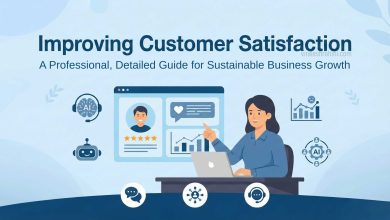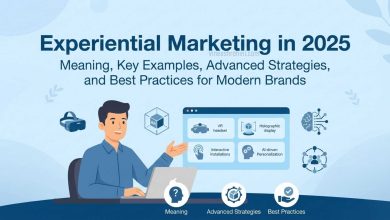E-Marketing and Its Strategies : Comprehensive Guide 2025
E-Marketing and Its Strategies : In the fast-paced digital age, e-marketing has emerged as a crucial strategy for businesses to reach their target audience effectively. With technological advancements and the increasing use of the internet, companies are leveraging digital platforms to promote their products and services.
Table of Contents
E-marketing, also known as digital marketing, encompasses various online strategies to engage customers, drive sales, and build brand awareness. This comprehensive guide explores the fundamentals of e-marketing, its key strategies, benefits, challenges, and future trends for 2025.
What is E-Marketing?

E-marketing refers to the use of electronic media and digital channels to promote brands, products, or services.
Also Read : What is User Generated Content ?
Unlike traditional marketing, which relies on offline methods such as television, radio, and print advertisements, e-marketing leverages the internet, social media, email, and other digital platforms to reach potential customers.
Importance of E-Marketing
E-marketing has revolutionized the way businesses interact with consumers. Some of its key benefits include:
- Global Reach – Businesses can connect with audiences worldwide without geographical limitations.
- Cost-Effectiveness – Compared to traditional marketing, e-marketing is more affordable and offers better ROI.
- Personalization – Companies can tailor content to specific customer preferences.
- Real-Time Analytics – Businesses can measure campaign effectiveness instantly.
- Enhanced Engagement – Interactive content and social media increase user engagement.
Key E-Marketing Strategies
To succeed in the digital landscape, businesses must implement effective e-marketing strategies. Below are some of the most impactful methods:
1. Search Engine Optimization (SEO)
SEO is the practice of optimizing a website to rank higher on search engine results pages (SERPs). It involves:
- Keyword Research: Identifying relevant keywords for better search visibility.
- On-Page SEO: Optimizing titles, meta descriptions, and content.
- Off-Page SEO: Building backlinks to improve domain authority.
- Technical SEO: Enhancing website speed, mobile-friendliness, and security.
2. Content Marketing
Content marketing focuses on creating valuable and relevant content to attract and retain customers. This includes:
- Blogging: Providing informative articles related to the industry.
- Infographics: Visual representation of data for better understanding.
- Videos: Engaging content for platforms like YT and TikTok.
- E-books & Whitepapers: Offering in-depth insights for lead generation.
3. Social Media Marketing (SMM)
Social media platforms play a vital role in modern marketing. Businesses use platforms like Fb, Insta, Twitter, LinkedIn, and TikTok to:
- Engage with their audience through posts and stories.
- Run paid ad campaigns targeting specific demographics.
- Collaborate with influencers to increase brand visibility.
4. Email Marketing
Email marketing remains one of the most effective ways to nurture leads and retain customers. Key aspects include:
- Personalized Email Campaigns: Sending tailored offers based on user behavior.
- Automated Drip Campaigns: Pre-scheduled emails that guide customers through the sales funnel.
- Newsletters: Regular updates about industry trends and company news.
5. PPC

PPC campaigns, such as G Ads and Fb Ads, allow businesses to reach potential customers through paid advertisements.
- Search Ads: Appear on search engine results pages.
- Display Ads: Banner ads displayed on websites.
- Remarketing Ads: Target users who have previously visited a website.
6. Affiliate Marketing
Affiliate marketing involves partnering with individuals or companies who promote products in exchange for a commission. This strategy is effective because:
- It leverages third-party influence.
- It provides a performance-based revenue model.
- It expands brand reach organically.
7. Influencer Marketing
Influencer marketing collaborates with social media influencers to promote products or services. Choosing the right influencers can:
- Increase credibility and trust.
- Drive high engagement rates.
- Enhance brand awareness among specific audiences.
8. Mobile Marketing
With the rise of smartphones, mobile marketing has become essential. This includes:
- SMS Marketing: Sending promotions via text messages.
- App-Based Marketing: Running ads within mobile applications.
- Mobile-Optimized Websites: Ensuring seamless browsing experience on smartphones.
9. Video Marketing
Video content has gained massive popularity, with platforms like YT, Insta Reels, and TikTok leading the way. Businesses use video marketing for:
- Product Demonstrations
- Customer Testimonials
- Live Streaming Events
10. Conversion Rate Optimization (CRO)
CRO focuses on enhancing a website’s performance to improve the percentage of visitors who take desired actions. This includes:
- A/B Testing: Comparing different versions of web pages.
- Call-to-Action (CTA) Optimization: Designing effective CTAs.
- User Experience (UX) Enhancement: Improving site navigation and design.
Challenges in E-Marketing
Despite its advantages, e-marketing presents several challenges:
- Increasing Competition: Businesses must innovate continuously to stand out.
- Data Privacy Concerns: Stricter regulations (GDPR, CCPA) require businesses to handle customer data responsibly.
- Algorithm Changes: Search engines and social media platforms frequently update their algorithms, affecting visibility.
- Ad Fatigue: Consumers may become overwhelmed by excessive advertising.
Future Trends in E-Marketing for 2025
E-marketing continues to evolve, and staying ahead requires businesses to adapt to emerging trends. Some key trends to watch in 2025 include:
- Artificial Intelligence (AI) and Automation
- AI-powered chatbots for customer service.
- Personalized content recommendations based on user behavior.
- Voice Search Optimization
- Optimizing content for voice assistants like Alexa and Google Assistant.
- Using conversational keywords for better search rankings.
- Augmented Reality (AR) and Virtual Reality (VR)
- Interactive shopping experiences using AR/VR.
- Virtual try-ons for fashion and beauty brands.
- Blockchain in Marketing
- Secure and transparent transactions.
- Reducing ad fraud through decentralized systems.
- Sustainable and Ethical Marketing
- Eco-friendly business practices.
- Social responsibility campaigns to connect with conscious consumers.
E-Marketing and Its Strategies – Conclusion

E-marketing is a dynamic and essential component of modern business strategies. By leveraging the right digital marketing techniques, businesses can reach their target audience effectively, enhance brand visibility, and drive sales.
Buy Now : Ecommerce Website With 100 Products
As technology advances, staying updated with emerging trends will be crucial for sustained success in the ever-evolving digital landscape of 2025.
Keywords : E-Marketing and Its Strategies – E-Marketing and Its Strategies 2025



